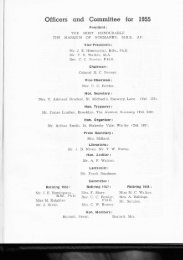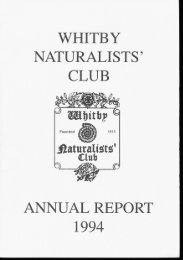2005 - Whitby Naturalists
2005 - Whitby Naturalists
2005 - Whitby Naturalists
Create successful ePaper yourself
Turn your PDF publications into a flip-book with our unique Google optimized e-Paper software.
THE BOTANICAL RECORDER'S REPORT<br />
Spring was very late to arrive in <strong>2005</strong>. January and February wcre mild<br />
sunny months, with thc ycar making an excellent start, but a cold snap<br />
with snow showers in March held the plants back. Further cold<br />
weather stopped growth and for the rest of the year the plants were t\Mo<br />
to three weeks later than normal. Just bcfore the bad weather in March<br />
i visited thc bank-sides below Old Mulgrave Castle to see the<br />
spectacular display of Snowdrops (Galanthus niqtalis) which appear<br />
every year. Do gt'r and see them! it was on the way down the path to<br />
Sandsend Beck that I discovercd a plant not recordcd in the area<br />
before, \X/hite Butterbur (Petasites albus), It is presumably a garCen<br />
escapc (possibly from Mulgrave Castle) hut it is well naturalised in tire<br />
lvet woodland and a nice addition to our local flora.<br />
After the club's trip to the Wildfowl Trust irr early lv{ay, our first iocai<br />
outing took us down Forge Vailey along the River Derwent starting<br />
lrom'Oid Man's Mouth' car park. All aiong the stream grows Large<br />
White Bittercress (Cardttrnine mtma\ which is quite an uncommon<br />
plant nationally but which is reported to grow in 116 of the 400<br />
two-kilometre squares in the North Yorkshirc Moors Flora. This plant<br />
is very similar to its sister, the Cuckoo Flower (Cardamine pratensis)<br />
also callcd lv{iikmaids and Lady's Smock. However, insteacl of having<br />
pinkish flowers and yellow stamens, Large \fhite Bittercress has pure<br />
white flowers and very noticeable violet anthers on its starnens. The<br />
petais of Large \fhite Bittercress are always greater than 6 mm, which<br />
separates it from its two smaller and common sister plants, Wavy<br />
Bittercress (Cdrdmnine tlexuosa) and Hairy Bittercress (Cardamine<br />
hirswa). These iatter two piants are coffectly separated by their<br />
number of stamens,'Silavy h:rs six and Hairy usuaily has four, seen with<br />
a hand lens. However, habitat is also a good guide bccause 'SUavy<br />
Bittcrcress usr:ally grows in wet places, stream-sicles, ditches, etc.<br />
whereas Hatry Bittcrcress is a plant of cultivated and waste ground,<br />
usually drier. Certainly one should not use hairiness as a character<br />
because Wavy Bittercress is distinctly puhcscent. I think that Hairy<br />
12




